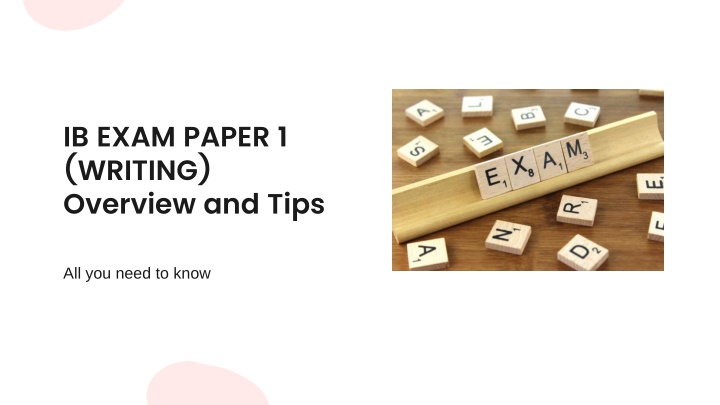
IB Exam Paper 1 Writing Overview & Tips - All You Need to Know
Discover essential details, text types, scoring, test-taking tips, and advice for a higher score in IB Exam Paper 1 (Writing). Learn about evaluation criteria, word count, and how the exam is graded to boost your performance. Get insights on choosing the right text type and maximizing your score with expert guidance.
Uploaded on | 0 Views
Download Presentation

Please find below an Image/Link to download the presentation.
The content on the website is provided AS IS for your information and personal use only. It may not be sold, licensed, or shared on other websites without obtaining consent from the author. If you encounter any issues during the download, it is possible that the publisher has removed the file from their server.
You are allowed to download the files provided on this website for personal or commercial use, subject to the condition that they are used lawfully. All files are the property of their respective owners.
The content on the website is provided AS IS for your information and personal use only. It may not be sold, licensed, or shared on other websites without obtaining consent from the author.
E N D
Presentation Transcript
IB EXAM PAPER 1 (WRITING) Overview and Tips All you need to know
Content Section 1: Essential Details Section 2: Essential "Text Types" to Know Section 3: Score Section 4: Test-Taking Tips Section 5: Advice for Higher Score Section 6: When Writing Each Text Type
Section 1: Essential Details Duration and Grading: The exam is administered in May and externally graded by the IB, lasting 1 hour and 15 minutes. It carries a weight of 30 points, accounting for 25% of the overall IB score. Word Count: Aim for a word count of 250-400 words, striving for 400 words. Evaluation Criteria: The exam is evaluated based on three criteria: Language (A), Message (B), Conceptual Understanding (C). These criteria are detailed below. Prompts and Text Types: The exam comprises three writing prompts rooted in any of the five IB themes, and students must choose one prompt and one of three suggested "text types" for their response.
Section 1.2: Evaluation Criteria Language ( Criterion A): Maximum of 12 points, evaluating grammar, vocabulary, and fluency. Message (Criterion B): Maximum of 12 points, focusing on effective topic selection, planning, and word count. Conceptual Understanding (Criterion C): Maximum of 6 points, emphasizing the selection of the most suitable text type and adherence to its conventions.
Section 2: Essential "Text Types" to Know Definition: Text types encompass various forms, including oral, written, and visual materials. Text type Advertisement Editorial article for newspaper or magazine letter to the editor personal letter formal letter Email Blog personal diary Essay Pamphlet Report Review Interview Speech.
Section 3: Score Total Marks: The maximum score for Exam Paper 1 (writing) is 30. Evaluation Rubrics: Exams are evaluated by IB examiners using three rubrics: Language (A), Message (B), and Conceptual Understanding (C).
Section 4: Test-Taking Tips Initial Steps: Before planning the response, students should highlight the situation or context identify the audience underline the purpose Text Type Selection: Choose the best text type by eliminating unsuitable options, aiming for the most fitting text type for optimal scoring.
Section 5: Advice for Higher Score Criterion A (Grammar and Vocabulary) Criterion B (Message) Criterion C (Understanding the Topic) Effective Topic Selection: Choose the topic one can write about most effectively Plan the essay Aim for the maximum word count. Language Utilization: Utilize various tenses, idiomatic expressions, and avoid repetitive vocabulary to enhance fluency and accuracy. Sentence Structure: Focus on crafting compound and complex sentences to enhance complexity and coherence. Text type Language style Purpose Audience These should match the tone.
Section 6: When Writing Each Text Type Goal: Understand the purpose of the writing. Audience: Identify the intended reader. Style: Determine the appropriate tone and level of formality. Mood: Consider the emotional tone or atmosphere. Norms: Understand the typical expectations or rules for the specific type of writing.
